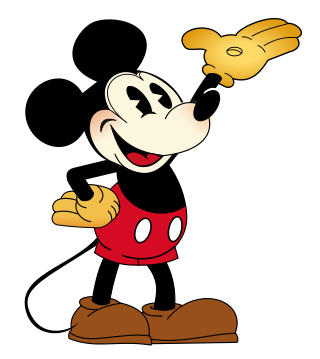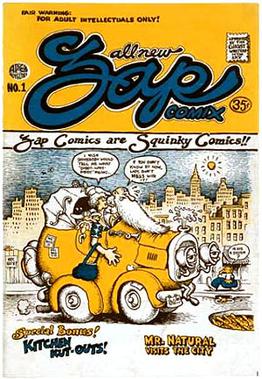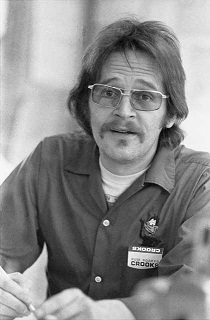Related Research Articles

Mickey Mouse is an American cartoon character co-created in 1928 by Walt Disney and Ub Iwerks. The longtime icon and mascot of the Walt Disney Company, Mickey is an anthropomorphic mouse who typically wears red shorts, large shoes, and white gloves.

Underground comix are small press or self-published comic books that are often socially relevant or satirical in nature. They differ from mainstream comics in depicting content forbidden to mainstream publications by the Comics Code Authority, including explicit drug use, sexuality, and violence. They were most popular in the United States in the late 1960s and 1970s, and in the United Kingdom in the 1970s.

Dan O'Neill is an American underground cartoonist, creator of the syndicated comic strip Odd Bodkins and founder of the underground comics collective the Air Pirates.
Paul Murry was an American cartoonist and comics artist. He is best known for his Disney comics, which appeared in Dell Comics and Gold Key Comics from 1946 to 1984, particularly the Mickey Mouse and Goofy three-part adventure stories in Walt Disney's Comics and Stories.

Last Gasp is a San Francisco–based book publisher with a lowbrow art and counterculture focus. Owned and operated by Ron Turner, for most of its existence Last Gasp was a publisher, distributor, and wholesaler of underground comix and books of all types.
Shary Flenniken is an American editor-writer-illustrator and underground cartoonist. After joining the burgeoning underground comics movement in the early 1970s, she became a prominent contributor to National Lampoon and was one of the editors of the magazine for two years.
Robert London is an American underground comix and mainstream comics artist. His style evokes the work of early American cartoonists like George Herriman and Elzie Crisler Segar.

Gary Hallgren is an American illustrator and underground cartoonist. Illustrations by Hallgren have been "commissioned by publications such as The New York Times, Men's Health, The Wall Street Journal, Mad, and Entertainment Weekly, among others."
Dirty Duck is a fictional character created by underground comix artist Bobby London. The style of the strip is an homage to George Herriman's Krazy Kat.

Dave Sheridan was an American cartoonist and underground comix artist. He was the creator of Dealer McDope and collaborated with Gilbert Shelton and Paul Mavrides on The Fabulous Furry Freak Brothers. As creative partner with fellow underground creator Fred Schrier, using the name "Overland Vegetable Stagecoach," they worked on Mother's Oats Funnies, published by Rip Off Press from 1970 to 1976.

The Uncensored Mouse is a 1989 comic book series published by Malibu Graphics' Eternity Comics line. The series reprinted Mickey Mouse comic strip stories from 1930, including the first two sequences, "Lost on a Desert Island" and "Mickey Mouse in Death Valley". Only two issues were published. While these early sequences had been reprinted in Italy in the 1970s, The Uncensored Mouse was the first English-language reprint since the strip's newspaper run.
Larry Fuller is an African-American underground comix writer, publisher, and promoter. Along with other such notables as Richard "Grass" Green, Guy Colwell, and Fuller's long-time business partner and friend, Raye Horne, Fuller made sure that the voices of black comic book creators were heard in a time when their artistic efforts were largely ignored. On the topics of race and sexuality, Fuller mastered the art of delivering social commentary in humorous form.

Donald Richard Donahue was a comic book publisher, operating under the name Apex Novelties, one of the instigators of the underground comix movement in the 1960s.
Gary Edson Arlington was an American retailer, artist, editor, and publisher, who became a key figure in the underground comix movement of the 1960s and 1970s. As owner of one of America's first comic book stores, the San Francisco Comic Book Company, located in San Francisco's Mission District, Arlington's establishment became a focal point for the Bay Area's underground artists. He published comics under the name San Francisco Comic Book Company, as well as publishing and distributing comics under the name Eric Fromm. Cartoonist Robert Crumb has noted, "Gary made a cultural contribution in San Francisco in the late 1960s, through the '70s, '80s & '90s that was more significant than he realizes."
Theodore Richards was an American web designer and cartoonist, best known for his underground comix.
The Sky River Rock Festival and Lighter Than Air Fair was a historic rock festival first held on a raspberry farm on the Skykomish River outside Sultan, Washington. The 1968 rock festival was held between August 31 to September 2. It was the first multi-day outdoor hippie rock festival at an undeveloped site. The line-up included bands the Grateful Dead, Santana, and others. The festival was held the next year on labor Day weekend August 30 and September 1, 1969 in Tenino, Washington, and finally on August 28 until September 8, 1970 in Washougal, Washington.

Company & Sons was an early underground comix publisher based in San Francisco, ran by John Bagley. The company operated from 1970 to 1973, publishing a total of 15 titles, all but one of them consisting of a single issue.

San Francisco Comic Book was an underground comix anthology published between 1970 and 1983. Conceived of and edited by Gary Arlington, the anthology highlighted the work of many of San Francisco's top underground talents, including Bill Griffith, Robert Crumb, Kim Deitch, Justin Green, Rory Hayes, Willy Murphy, Jim Osborne, Trina Robbins, and Spain Rodriguez.
Willy Murphy was an American underground cartoonist. Murphy's humor focused on hippies and the counterculture. His signature character was Arnold Peck the Human Wreck, "a mid-30s beanpole with wry observations about his own life and the community around him." Murphy's solo title was called Flamed-Out Funnies; in addition, he contributed to such seminal underground anthologies as Arcade, Bijou Funnies, and San Francisco Comic Book, as well as the National Lampoon.

Walt Disney Productions v. Air Pirates, 581 F.2d 751 (1978), was a copyright law case of the United States Court of Appeals for the Ninth Circuit, and an important precedent on the use of copyrighted characters for purposes of parody or satire.
References
Notes
- 1 2 3 4 Tom Sito (October 6, 2006). Drawing the Line: The Untold Story of the Animation Unions from Bosko to Bart Simpson. University Press of Kentucky. pp. 236–37. ISBN 0-8131-7148-2.
- ↑ {{cite web |url=https://cbldf.org/2013/05/disneys-bloody-attack-on-the-air-pirates/ |title= Disney’s Bloody Attack on The Air Pirates |last=Gomez |first=Betsy |last2=Levin |first2=Bob |date=May 6, 2013 |website=[[Comic Book Legal Defense Fund |access-date=April 26, 2024 |quote=As the ’60s cultural revolution roared on, O’Neill decided that what America truly needed was the destruction of Walt Disney. So after the Chronicle canned him, he rounded up a ragtag band of rogue cartoonists who called themselves the Air Pirates, after a group of evildoers who had bedeviled Mickey Mouse in the 1930s. In 1971 they produced two issues of an underground comic book in which a number of Disney characters, particularly Mickey, engaged in very un-Disneylike behavior, particularly sex.}}
- ↑ Sacks, Jason; Dallas, Keith (2014). American Comic Book Chronicles: The 1970s. TwoMorrows Publishing. pp. 58–59. ISBN 978-1605490564.
- ↑ Merton of the Movement (Cocoanut Comix/Last Gasp, Oct. 1972).
- 1 2 Ringgenberg, S.C. "Bobby London and the Air Pirates Follies," Archived 2011-07-16 at the Wayback Machine Comix Art & Graffix Gallery (5-12-98).
- 1 2 Patrick Rosenkranz (2002). Rebel Visions: the Underground Comix Revolution, 1963-1975. Fantagraphics Books. ISBN 978-1-56097-464-2.
- ↑ Donahue, Don and Susan Goodrick, editors. The Apex Treasury of Underground Comics (Links Books/Quick Fox, 1974), p. 153.
- ↑ Boyd, Robert. "The Shary Flenniken Interview," The Comics Journal #146 (November 1991): "We were up here from 1973 'til '76. We broke up and Bobby went back to New York."
- ↑ Brand, Stewart (Summer 1979). ""Disney Sues O'Neill, Brand and POINT"". Co-Evolution Quarterly. No. 22. p. 140.
- 1 2 Bob Levin (2003). The Pirates and the Mouse: Disney's War Against the Counterculture . Fantagraphics Books. ISBN 1-56097-530-X.
- ↑ Travers, Peter (1989-06-14). "Comic Book Confidential". Rolling Stone. Retrieved 2024-02-04.
- ↑ Howe, Desson (August 18, 1989)."Comic Book Confidential". The Washington Post .